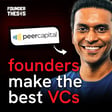
The ‘reluctant’ founder pioneering energy transition | Bhaktha Keshavachar @ Chara Technologies
Once a tech wizard at Intel, Bhaktha Keshavachar shifted gears to co-found Ezetap that shook up India's fintech scene with its innovative digital payment solutions, and was eventually acquired by Razorpay. Now, at Chara Technologies, he is engineering a revolutionary Reluctance motor engine that's free of toxic rare-earth minerals.This nifty invention is not just eco-friendly and cost- effective, but is also set to slash India's import dependency and give a turbo boost to the nation's electric mobility dreams!
Get notified about the latest releases and bonus content by subscribing to our newsletter at www.founderthesis.com
Read more about Chara Technologies:-
2.As the EV market vrooms, this Bengaluru start-up tries to get its motor running
3.Trio Builds EV Motors With No Toxic Rare-Earth Metals, Cut Dependency on Imports



















